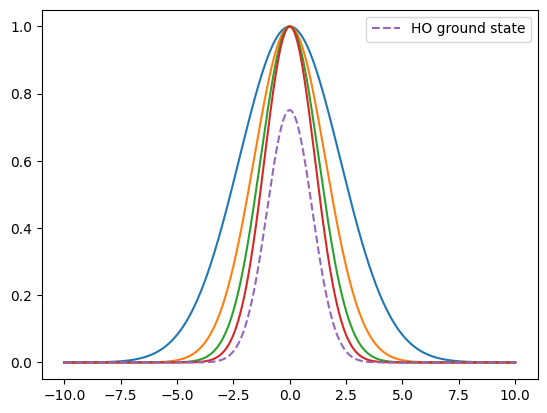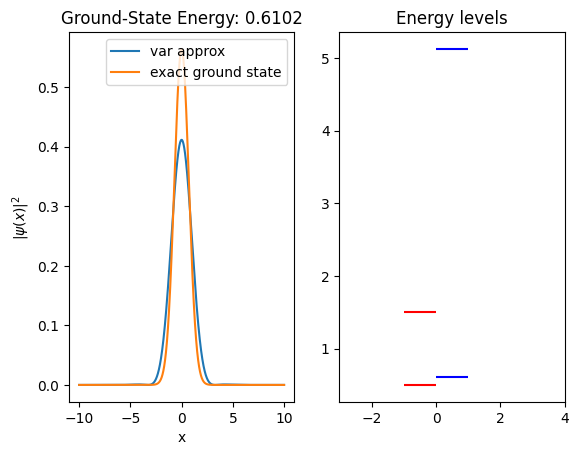DEMO: Solving QM problems with Variational method#
import numpy as np
import scipy as sp
from scipy.linalg import eigh
import matplotlib.pyplot as plt
Harmonic Oscillator#
def psi0(x):
'''Normalized ground state wavefunction of harmonic oscillator
The following units used; hbar=1, mu=1, k=1
'''
return np.pi**(-0.25)*np.exp(-0.5 * x **2 )
def E0(n):
'''Eiganvalues of harmonic oscillator
The following units used; hbar=1, mu=1, k=1 making omega=1'''
return (n+1/2)
Write functions to compute matrix elements#
def basis_functions(x, n, alpha=0.1, beta=0):
'''Define any 1D trial function you like.
n: is a parameter that defines basis functions in a linear combination, n=1,2,3,...
alpha: is a constat that can also be varied.
e.g c_1 f_1+c_2f_2+...'''
n=n+1 # n=1,2,3,4...
return np.exp(-alpha*n*(x-beta)**2)
# Define the potential energy function for your quantum system
def PE(f, x):
'''Potential energy with the following units used; hbar=1, mu=1, k=1
'''
return 0.5 * x**2 * f # Harmonic oscillator potential as an example
def KE(f, dx):
'''Kinetic energy operator, with the following units used; hbar=1, mu=1, k=1
f: a 1D array of length N
dx: spacing between points
'''
dfdx = np.gradient(f, dx)
df2dx2 = np.gradient(dfdx, dx)
return -0.5*df2dx2
x = np.linspace(-10, 10, 10000)
for n in range(4):
plt.plot(x, basis_functions(x, n))
plt.plot(x, psi0(x), '--', label='HO ground state')
plt.legend()
<matplotlib.legend.Legend at 0x7f5958cf5a60>

Test for numerical accuracy#
x = np.linspace(-10, 10, 10000)
dx=x[1]-x[0]
#Check normalization, should be 1
norm = np.trapz(psi0(x)**2, x=x)
print(norm)
#Check ground energy 1/2 hbar omega = 1/2 (because h=1 and omega=1 because k=1, mu=1)
Hii = np.trapz(psi0(x) * KE(psi0(x), dx) + psi0(x) * PE(psi0(x), x) , x=x)
print(Hii)
1.0
0.49999949990084436
Solve eigenvalue problem#
# Define the number of basis functions and the range of x
num_basis_functions = 2
# Compute the overlap matrix and Hamiltonian matrix
S = np.zeros((num_basis_functions, num_basis_functions))
H = np.zeros((num_basis_functions, num_basis_functions))
for i in range(num_basis_functions):
for j in range(num_basis_functions):
fi, fj = basis_functions(x, i), basis_functions(x, j)
S[i, j] = np.trapz(fi * fj, x=x)
H[i, j] = np.trapz(fi * KE(fj, dx) + fi * PE(fj, x), x=x)
# Diagonalize the matrices to find eigenvalues and eigenvectors
eigenvalues, eigenvectors = eigh(H, S)
# Find the ground-state energy (lowest eigenvalue) and corresponding eigenfunction
ground_state_energy = eigenvalues[0]
ground_state_wavefunction = eigenvectors[:, 0]
print(f"Ground-State Energy: {ground_state_energy}")
print(f"Ground-State Wavefunction Coefficients: {ground_state_wavefunction}")
Ground-State Energy: 0.6102313319882992
Ground-State Wavefunction Coefficients: [ 0.33492713 -0.97644553]
Visualize Eigenfunctions and eigenvalues#
psi = 0 # trial function
k = 0 # eigenvector
fig, (ax1, ax2) = plt.subplots(ncols=2)
for i in range(num_basis_functions):
psi += eigenvectors[:, k][i] * basis_functions(x, i)
ax1.plot(x, psi**2, label='var approx')
ax1.plot(x, psi0(x)**2, label='exact ground state')
ax1.legend()
ax1.set_title(f"Ground-State Energy: {ground_state_energy:.4f}")
ax1.set_xlabel('x')
ax1.set_ylabel('$|\psi(x)|^2$')
for n, level in enumerate(eigenvalues):
plt.hlines(E0(n), -1, -0.001, colors='red', linestyles='-', label=f'Level {n+1}')
plt.hlines(level, 0, 1, colors='blue', linestyles='solid', label=f'Level {n+1}')
ax2.set_xlim(-3, 4)
ax2.set_title('Energy levels')
Text(0.5, 1.0, 'Energy levels')


